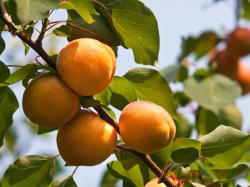Warmer Winter Seasons To Impact Fruit & Nut Industries
June 1, 2011 | 3 min to read

Arlington, VA – The first-ever global analysis of the impacts of climate change on fruit and nut trees finds that an important determining factor for crop yields will be impacted, posing a risk of substantial economic losses for an industry worth an estimated US $93 billion annually.
An increasingly shortening "winter chill" period each year due to warming in many key growing regions is impacting agricultural production of fruits and nuts, according to a study published today in the online journal PLoS ONE.
"Changes in winter seasons will change the ranges of many tree crops, and many growing regions may become unsuitable for some of our favorite fruits that are grown on trees," said Evan Girvetz, senior climate scientist at The Nature Conservancy and co-author of the report, "especially apples, cherries, and peaches." The report also notes that other fruits and nuts such as apricots, walnuts, pistachios, plums and almonds will be affected by decreased "winter chills."
The study, "Climate change affects winter chill for temperate fruit and nut trees," was led by Eike Luedeling of the World Agroforestry Centre in Nairobi, Kenya. Co-authors include Girvetz of The Nature Conservancy, Patrick H. Brown of the University of California, Davis, and Mikhail A. Semenov of Rothamsted Research in Harpenden, United Kingdom.
Using observed daily weather for more than 4,000 weather stations around the world from the National Climatic Data Center of the U.S. and climate projections from three global climate models, the analysis estimates winter chill for two past years (1975 and 2000) and generates 18 future scenarios (at the middle and end of the 21st century) for the entire globe with The Nature Conservancy's ClimateWizard tool. Results can be found at treephenology.ucdavis.edu.
The analysis uses "Safe Winter Chill (SWC)," the amount of winter chill that is exceeded in 90 percent of all years. This metric is meaningful to fruit and nut producers, according to the researchers, because failure to meet chilling requirements in more than 10 percent of years is likely to render production uneconomical. Each type of tree has a specific chilling requirement; trees must receive a certain amount of winter chill. Traditionally, this has been expressed as the number of chilling hours (one hour at between 32 and 45 degrees Fahrenheit), but the authors found chill portions, another measure of winter chill, more suitable for climate change analysis.
The study finds that warm growing regions are likely to experience severe reductions in available winter chill, regardless of the emissions scenario or climate model used, potentially threatening current production in places like the Sacramento Valley in California, the Southeastern United States, Chile's Valle Central, Yunnan Province in China, South and Northern Africa, as well as South and Southwestern Australia.
"For most future scenarios and most growing regions, we can probably find trees that already exist, which will be well suited for predicted climate conditions. The challenge is to anticipate changes and plant cultivars now that are in tune with chilling conditions for the future. If such planning is done well, disruption to fruit and nut supply may be minimal," said co-author Luedeling.
The authors suggest that while efforts to reduce carbon pollution may slow anticipated warming trends, growers and plant scientists will likely need to adapt to changing conditions by breeding tree cultivars for lower chilling requirements, developing tools to cope with insufficient winter chill, and better understanding the temperature responses of tree crops. These adaptation measures may be expensive, perhaps pricing small producers out of the industry.
"Of course these fruits and nuts aren't going away – but as it becomes increasingly more expensive to take care of them, and these costs may be passed onto the consumers," said Girvetz, "consumers need to call on industry to listen closely to this research to ensure their food remains secure."
Source: The Nature Conservancy
